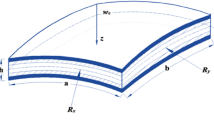Abstract
An experimental study was conducted for the fluid–structure interaction (FSI) of the vibration of a flexible structure inside the channel driven cavity flow (CDCF). The structure was a thin flat plate whose one edge was clamped at the bottom of the three-dimensional CDCF system. Both aluminum and composite plates were examined. Initially the vibrational characteristics of the structures were measured without fluid flow. Subsequently, each structural vibration was measured under various flow rates through the CDCF system. The structural vibration was measured using strain gages attached to the structures as well as non-contact displacement sensors. Time histories of the strains and displacements were obtained, and their time averages and the vibrational magnitudes were computed as a function of the nominal flow rate through the channel cross-section. This set of test data is expected to be useful for validation of a computer program for analyzing a FSI problem.





















Similar content being viewed by others
References
Aidun CK, Clausen JR (2010) Lattice–Boltzmann method for complex flows”. Annu Rev Fluid Mech 42(1):439–472
Blair SR, Kwon YW (2015) Modeling of fluid–structure interaction using Lattice Boltzmann and finite element methods. ASME J Pressure Vessel Technol 137:021302
Chen S, Doolen GD (1998) Lattice Boltzmann method for fluid flows. Annu Rev Fluid Mech 30(1):329–364
Craugh LE, Kwon YW (2013) Coupled finite element and cellular automata methods for analysis of composite structures with fluid–structure interaction. Compos Struct 102:124–137
Frisch U, Hasslacher B, Pomeau Y (1986) Lattice-gas automata for the Navier–Stokes equation. Phys Rev Lett 56:1505–1508
Hao J, Zhu L (2010) A lattice Boltzmann based implicit immersed boundary method for fluid structure interaction. Comput Math Appl 59:2010
Hirt CW, Nichols BD (1981) A computational method for free surface hydrodynamics. ASME J Pressure Vessel Technol 103(2):136–141
Kwon YW (2016) Multiscale and multiphysics modeling techniques and applications. CRC Press, Boca Raton
Kwon YW (2017) Finite difference-based cellular automaton technique for structural and fluid–structure interaction applications. ASME J Pressure Vessel Technol 139:041301
Kwon YW, Arceneaux SM (2017) Experimental study of channel driven cavity flow for fluid–structure interaction. ASME J Pressure Vessel Technol 139(3):034502
Kwon YW, Bang HC (2000) The finite element method using Matlab, 2nd edn. CRC Press, Boca Raton
Kwon YW, Bowling JD (2018) Dynamic responses of composite structures coupled through fluid medium. Multiscale Multidiscip Model Exp Design 1(1):69–82
Kwon YW, Hosoglu S (2008) Application of Lattice Boltzmann method, finite element method, and cellular automata and their coupling to wave propagation problems. Comput Struct 86:663–670
Kwon YW, Jo JC (2009) Development of weighted residual based lattice Boltzmann techniques for fluid–structure interaction application. ASME J Pressure Vessel Technol 131(3):031304
Kwon YW, Priest EM, Gordis JH (2013) Investigation of vibrational characteristics of composite beams with fluid–structure interaction. Compos Struct 105:269–278
Nourgaliev R, Dinh T, Theofanous T, Joseph D (2003) The lattice Boltzmann equation method: theoretical interpretation, numerics and implications. Int J Multiph Flow 29:117–169
Zhou H, Mo G, Wu F, Zhao J, Rui M, Cen K (2012) GPU implementation of lattice Boltzmann method for flows with curved boundaries. Comput Methods Appl Mech Eng 225–228:65–73
Acknowledgements
This work was supported by Office of Naval Research (ONR), and the Program Manager is Dr. Yapa Rajapakse.
Author information
Authors and Affiliations
Corresponding author
Ethics declarations
Conflict of interest
On behalf of all authors, the corresponding author states that there is no conflict of interest.
Additional information
Publisher’s Note
Springer Nature remains neutral with regard to jurisdictional claims in published maps and institutional affiliations.
Rights and permissions
About this article
Cite this article
Kwon, Y.W., Bowling, J.D. Experimental study of vibration of metallic and composite plates inside channel driven cavity flow. Multiscale and Multidiscip. Model. Exp. and Des. 1, 211–220 (2018). https://doi.org/10.1007/s41939-018-0021-0
Received:
Accepted:
Published:
Issue Date:
DOI: https://doi.org/10.1007/s41939-018-0021-0




